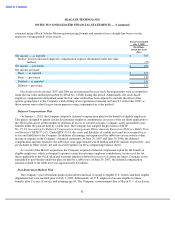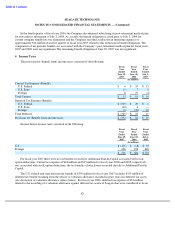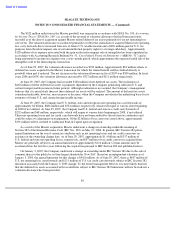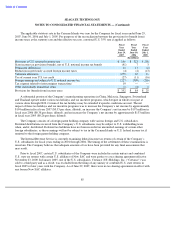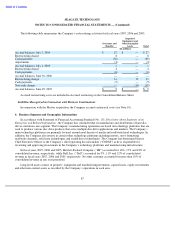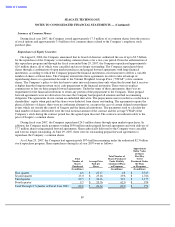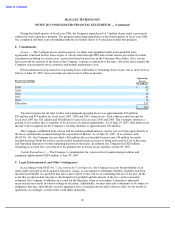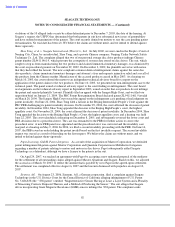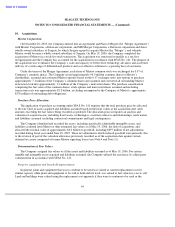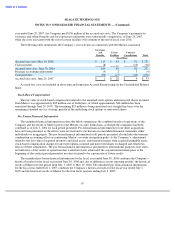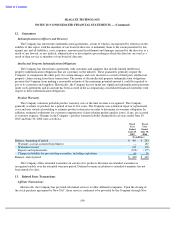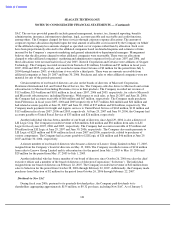Seagate 2006 Annual Report Download - page 94
Download and view the complete annual report
Please find page 94 of the 2006 Seagate annual report below. You can navigate through the pages in the report by either clicking on the pages listed below, or by using the keyword search tool below to find specific information within the annual report.
Table of Contents
SEAGATE TECHNOLOGY
NOTES TO CONSOLIDATED FINANCIAL STATEMENTS — (Continued)
Intellectual Property Litigation
Convolve, Inc. and Massachusetts Institute of Technology (“MIT”) v. Seagate Technology LLC, et al.
Between
1998 and 1999, Convolve, Inc., a small privately held technology consulting firm founded by an MIT Ph.D., engaged
in discussions with Seagate Technology, Inc. with respect to the potential license of technology that Convolve
claimed to own. During that period, the parties entered into non-disclosure agreements. We declined Convolve’s
offer of a license in late 1999. On July 13, 2000, Convolve and MIT filed suit against Compaq Computer Corporation
and us in the U.S. District Court for the Southern District of New York, alleging patent infringement,
misappropriation of trade secrets, breach of contract, tortious interference with contract and fraud relating to
Convolve and MIT’s Input Shaping
®
and Convolve’s Quick and QuietTM technology. The plaintiffs claim their
technology is incorporated in our sound barrier technology, which was publicly announced on June 6, 2000. The
complaint seeks injunctive relief, $800 million in compensatory damages and unspecified punitive damages. We
answered the complaint on August 2, 2000 and filed counterclaims for declaratory judgment that two Convolve/MIT
patents are invalid and not infringed and that we own any intellectual property based on the information that we
disclosed to Convolve. The court denied plaintiffs’ motion for expedited discovery and ordered plaintiffs to identify
their trade secrets to defendants before discovery could begin. Convolve served a trade secrets disclosure on
August 4, 2000, and we filed a motion challenging the disclosure statement. On May 3, 2001, the court appointed a
special master to review the trade secret issues. The special master resigned on June 5, 2001, and the court appointed
another special master on July 26, 2001. After a hearing on our motion challenging the trade secrets disclosure on
September 21, 2001, the special master issued a report and recommendation to the court that the trade secret list was
insufficient. Convolve revised the trade secret list, and the court entered an order on January 1, 2002, accepting the
special master’s recommendation that this trade secret list was adequate. On November 6, 2001, the USPTO issued
US Patent No. 6,314,473 to Convolve. Convolve filed an amended complaint on January 16, 2002, alleging
defendants’ infringement of this patent, and we answered and filed counterclaims on February 8, 2002. Discovery is
in process. On July 26, 2002, we filed a Rule 11 motion challenging the adequacy of plaintiffs’ pre-filing
investigation on the first two patents alleged in the complaint and seeking dismissal of plaintiffs’ claims related to
these patents and reimbursement of attorney’s fees. The court denied our motion on May 23, 2003. We believe that
the claims are without merit, and we intend to defend against them vigorously. On May 6, 2003, the USPTO issued
to Convolve U.S. Patent No. 6,560,658 B2, entitled “Data Storage Device with Quick and Quiet Modes.” Convolve
has indicated that it will seek leave of the court to add this patent to the lawsuit. This latest patent is a continuation of
a patent currently in the lawsuit (U.S. Patent No. 6,314,473). We similarly believe any claims that may relate to this
continuation patent would be without merit, regardless of whether such claims were added to the ongoing litigation
or asserted against us in a separate lawsuit. Judge John Martin, who was assigned this case, announced his retirement
from the federal bench. The case was reassigned to Judge George B. Daniels.
On October 14, 2003, the Special Master resigned from the case due to Convolve’s claim that he had a conflict
of interest. Magistrate Judge James C. Francis IV was appointed to handle all discovery matters. Plaintiffs have
indicated that they will dismiss claims regarding U.S. Patent No. 5,638,267 from the case. The claims construction
hearing on U.S. Patent Nos. 4,916,635 and 6,314,473 was held on March 30 and 31, 2004. On August 11, 2005, the
court entered an order construing the patent claims. Both Seagate and Compaq moved for reconsideration of its claim
construction in light of intervening new law in the Federal Circuit’s recent decision in Phillips v. AWH Corp., et al. ,
415 F.3d 1303 (Fed. Cir. 2005). Convolve also moved for clarification. The court denied reconsideration without oral
argument on December 7, 2005. The court later granted Convolve’s unopposed clarification motion. On March 29,
2006, the court granted Seagate’s summary judgment motion that Convolve’s fraud, tortious interference with
contract, unfair competition, and breach of confidence claims are preempted by the California Uniform Trade Secrets
Act (CUTSA). The court also held that while Convolve’s claim for breach of the covenant of good faith and fair
dealing is not preempted by the CUTSA, no tort damages are available. The court denied our motion for summary
judgment on a trade secret issue, finding there is an issue of fact that must be decided. Finally, the court entered an
order on July 14, 2006, that Convolve has no evidence to prove its claims regarding 10 alleged trade secrets,
precluding Convolve from proceeding at trial on those claims, and precluding Convolve from alleging
91


